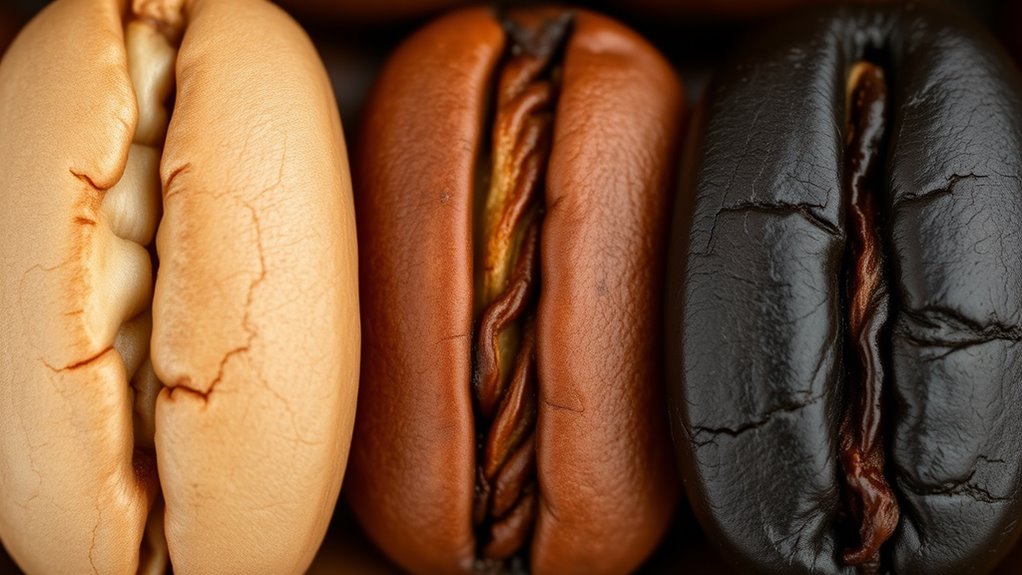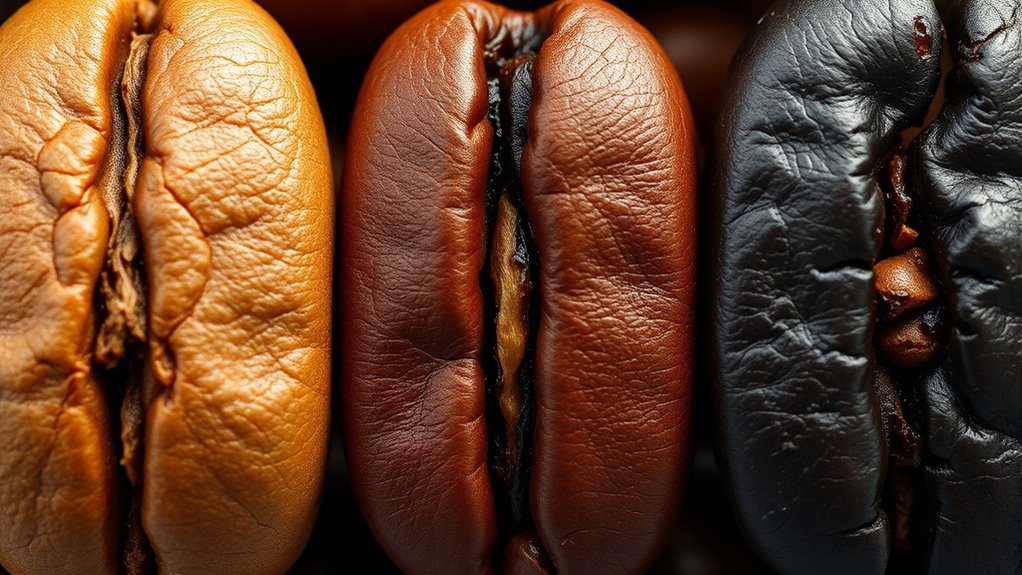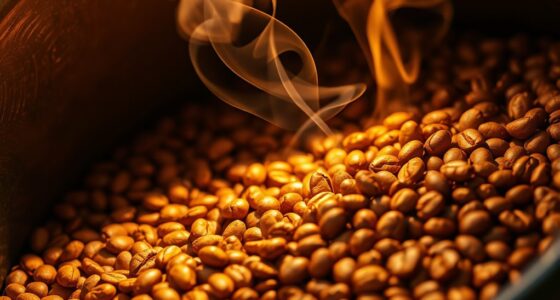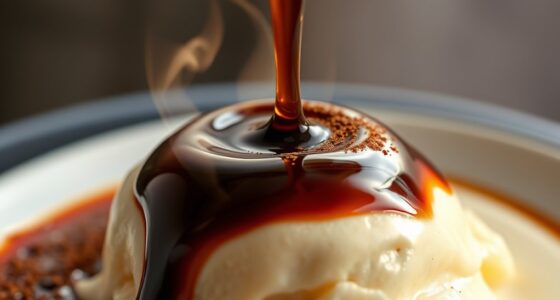Coffee roasts come in three main levels: light, medium, and dark, each offering unique flavors and qualities. Light roasts are bright and fruity, highlighting the beans’ original taste, with no surface oil. Medium roasts balance origin and roasted flavors, creating a versatile brew. Dark roasts are bold, smoky, and rich, with oily beans and intense flavor. Understanding these differences helps you choose based on your flavor preferences—keep exploring to learn more about what makes each roast special.
Key Takeaways
- Light roasts are light brown, preserve origin flavors, and have bright acidity with floral or fruity notes.
- Medium roasts are medium brown, balanced in flavor, with reduced acidity and subtle caramel or nutty tones.
- Dark roasts are dark brown to black, oily, and feature bold, smoky, and bitter flavors with less origin character.
- Roasting temperature and duration increase from light to dark, affecting physical traits like expansion, oiliness, and moisture loss.
- Choice of roast impacts flavor profile, aroma, and physical properties, tailoring coffee to individual taste preferences.

Ever wondered how different coffee roasts influence flavor and aroma? The way beans are roasted considerably impacts their taste, aroma, and physical characteristics.
Discover how coffee roast levels shape flavor, aroma, and physical traits for a perfect brew.
When you start with a light roast, often called Cinnamon or City, the beans are a light brown color with no oil on the surface. These beans retain most of their original flavors from the coffee’s terroir, meaning you’ll notice bright acidity and floral or fruity notes like blueberry or jasmine. Light roasts are roasted at temperatures around 350-400°F and are usually stopped during or just after the first crack, which occurs at roughly 385°F. They’re denser and have less surface oil, allowing their delicate flavors to shine through.
As the roast progresses to medium levels, sometimes called City+ or Full City, the beans turn a milk chocolate brown. They develop a more balanced profile, blending the origin flavors with caramel or nutty tones. Medium roasts are roasted at temperatures between 410-440°F and typically finish near the second crack at about 425°F. These beans undergo more heat and time, around 8-10 minutes, resulting in a slight expansion and minimal oil on the surface.
The flavor complexity deepens, and acidity diminishes, making them versatile for various brewing styles. You’ll notice a richer body with hints of caramel or toasted nuts, and the original terroir still plays a role but is less prominent.
Dark roasts, often called French or Italian, reach higher temperatures of 450-480°F and extend beyond the second crack, which occurs at approximately 440-450°F. These beans are visibly darker, nearing black, with an oily sheen on their surface due to the prolonged roasting process. The beans expand by 15-20%, become porous, and lose about 18-22% of their moisture.
Their flavor profile shifts dramatically, dominated by bitter, smoky, charred notes with undertones of chocolate and earth. The roasting process takes longer—over 12 minutes—and involves deeper Maillard reactions, creating bold, intense flavors. In this stage, the original origin flavors are largely faded, replaced by roasted and burnt characteristics.
Understanding these differences helps you choose the right roast for your taste. Light roasts highlight the bean’s inherent qualities, while medium roasts strike a balance, and dark roasts emphasize bold, roasted flavors. Each level offers unique sensory experiences, influenced by roasting temperature, time, and physical changes in the beans.
Whether you prefer the bright acidity of a light roast or the smoky richness of a dark roast, knowing these distinctions enhances your appreciation of coffee’s complexity. So next time you pick your beans, consider how the roast level shapes your cup—what you taste and smell directly results from this essential roasting process.
Frequently Asked Questions
How Does Roast Level Affect Coffee Acidity?
You’ll notice that as you roast coffee longer, its acidity decreases. Higher roasting temperatures and extended times break down acids like chlorogenic acid, making the brew less tangy.
Light roasts hold onto more organic acids, giving a brighter, more acidic taste. Dark roasts, having undergone more heat, lose much of their acidity, resulting in a smoother, mellower flavor profile.
Are Dark Roasts More Caffeinated Than Light Roasts?
Like a puzzle with missing pieces, the myth that dark roasts have more caffeine isn’t quite right. You might think darker means more, but in reality, both contain similar caffeine levels when measured by weight.
Light roasts are actually denser, so they can have slightly more caffeine per scoop.
Which Roast Type Is Best for Brewing Methods?
When choosing the best brewing method, consider the roast type you’re using. For light roasts, pour-over works great to highlight their complex flavors.
Dark roasts thrive with French press, which brings out their boldness.
Medium roasts suit drip brewing, offering a balanced taste.
Adjust your grind size and brew time to optimize flavor, and don’t hesitate to experiment to find your perfect method for each roast.
How Does Roasting Time Influence Flavor Complexity?
Roasting time truly transforms flavor, forging a fuller, more intricate cup. When you extend roasting, you allow chemical changes to develop deeper, richer notes, enhancing complexity.
Shorter roasts keep flavors fresh but simple, while longer roasts reveal layers of nuances like chocolate, fruit, or spice. By precisely timing your roast, you balance brightness with depth, crafting an engaging, complex coffee that delights every discerning sip.
Can Roasting Process Impact Coffee Health Benefits?
You might wonder if roasting affects coffee’s health benefits. It does—higher heat during roasting can reduce antioxidant levels, which are essential for health.
The longer or darker the roast, the fewer antioxidants you get, but caffeine might increase. So, if you’re after antioxidants, lighter roasts are better.
But if caffeine is your focus, darker roasts could be more appealing.
Conclusion
Now that you know the differences between light, medium, and dark roasts, you can find your perfect cup. Remember, it’s all about personal taste—there’s no one-size-fits-all. Whether you prefer a bright and lively brew or a bold, smoky flavor, the right roast is just around the corner. Don’t judge a book by its cover; give each roast a try and discover what truly makes your mornings brighter. Happy brewing!









